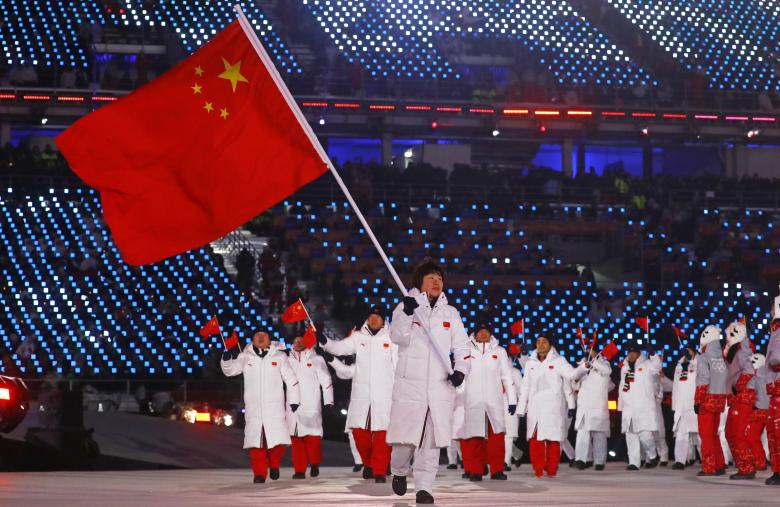
Two-time Olympic gold medalist Zhou Yang carries the Chinese flag during the opening ceremony of the PyeongChang Olympics, February 9, 2018. Photo: Reuters
Training, hard work, anddedication may end with a medal, but there’s no clear-cutpath to becoming a team’s flag bearer at the Olympics.
The Parade of Nations segment during the Opening Ceremony of the Olympic Games is the highlight of the evening for many. It’s probably the only reason why I watch the event.
What makes it interesting for many, are the individual flag bearers. How and why a flag bearer was chosen to represent a team and nation is a popular topic of conversation. The role is arguably one of the most unique accomplishments in sports.
The process that goes into deciding who gets to carry the flag varies among nations. With Team USA, the athletes choose.
According to the rules set forth by the US Olympic Committee, in the event of a tie, the winner is to be determined by a coin toss. As everyone knows by now, this happened at PyeongChang. Out of the 244 athletes on Team USA, the flag bearer honor came down to luge legend Erin Hamilton and speed skater Shani Davis.
Without either athlete present, a coin was flipped. When it was announced that Hamilton would carry the team’s flag, Davis, a two-time Olympic medal winner tweeted, “@TeamUSA dishonorably tossed a coin to decide its 2018 flag bearer. #BlackHistoryMonth2018.”
What did his team do to him?
Davis, who is black, felt the honor should have gone to him partly because February is Black History Month in the US. His reaction was unfair to Hamilton which put her on the spot on the spot and tainted the once-in-a-lifetime experience.
Was it Hamilton’s fault because she won? Davis didn’t attend the opening ceremony citing his heavy training schedule. It wouldn’t be the same US team without drama or tweeting, as audiences back home need something to discuss.
Other teams leave their issues in the locker room, which is where they belong.
China’s athletes arrived ready to compete, but with also welcomed anticipation that in four years, it’s going to be their turn to host the event.
When Vice Deputy of China’s Olympic delegation Gao Zhidan announced that Zhou Yang, a female speed skater from Jilin Province would be the team’s flag bearer, he explained, “She was a gold medalist in the Winter Olympics in Sochi and Vancouver. Most importantly, she overcame age and injuries, a reflection of our athletes’ spirit, and dedication.”
Upon hearing the news, Zhou jokingly told one reporter she had heard the flag was heavy and wondered if she should start working on her arm strength.
Athletic focus at the Olympic level is something only Olympic athletes can understand. For those on the outside looking in, comprehending what takes to get there is something we’ll never fully grasp.
Team Australia’s Lydia Lassila, gold medal aerial skier, and five-time Olympian turned down the opportunity to be Australia’s flag bearer and said, “I value performance and not extra-curricular items.” I can respect that.
But the most significant moment of the ceremony was not about one, but rather two flag bearers.
North and South Korea entered PyeongChang Olympic Stadium together under the unified Korean flag.
It wasn’t the first time they’ve marched together during an Olympic ceremony, but it was a first for them to do so on the Korean peninsula. When Seoul hosted the 1988 Summer Games, North Korea did not attend.
North Korean ice hockey player Hwang Chung Gum and South Korean bobsledder Won Yun-jong together held the unified Korean flag.
Leaders, dignitaries, and even Kim Jong-un’s sister, Kim Yo-jong stood and applauded while the South and North Korean teams marched together. US Vice President Mike Pence and his wife remained seated.
For a role that doesn’t require much physical strength and stamina, it’s influence and the message it can send is everlasting.


